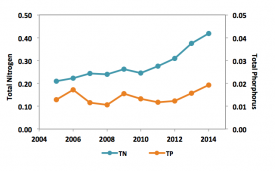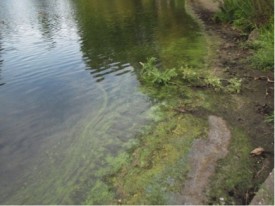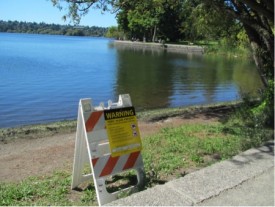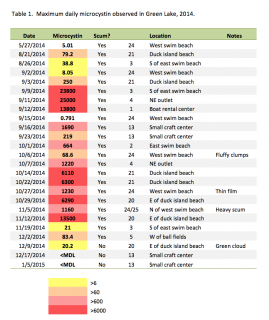By Rachael Gravon and Sally Abella, King County Lakes Program
Algal blooms have been observed since the early 1900s in Green Lake, a popular urban lake in north Seattle. Cyanobacterial toxicity has been measured intermittently since the 1990s, and in 1999 Green Lake was closed to recreational use due to high levels of algal toxins. Lake use has since been restricted several times, including both 2013 and 2014.
Cyanobacteria thrive in warm conditions, and recent summers may have provided opportunities for higher growth rates. Additionally, algal growth can be spurred by increased inputs of phosphorus and nitrogen via groundwater, sediment recycling, and stormwater runoff. Green Lake was treated with alum in both 1991 and 2004 to reduce the amount of phosphorus in the water column available for algal uptake. Both phosphorus and algae decreased after the 2004 treatment, but have been increasing since 2011 (Figure 1). A third alum treatment is currently scheduled for 2016.
Extensive toxicity testing was done in 2014 because of the patchy nature of scum formation and the concentrations of toxins. Members of Friends of Green Lake and volunteers from the King County Lake Stewardship Program made shoreline observations on a near-daily basis, reporting to city and county staff and taking scum samples for analysis. These were submitted to the King County Environmental Laboratory approximately weekly from mid-August through early December. Multiple samples were often collected on a given day, from areas with and without visible algal accumulations, to characterize the patchiness of toxin distribution.
The Washington Department of Ecology (DOE)’s Toxic Algae Program sponsored much of the testing, while routine samples were collected at the two swimming beaches as part of the King County swim beach monitoring program. The beach monitoring program also funded further scum sampling in the fall. Every sample was analyzed for microcystin, the most commonly occurring algal toxin in Green Lake. Anatoxin-a was analyzed through early September, but was discontinued after none was detected. Results were posted on the Washington State Toxic Algae Program website (https://www.nwtoxicalgae.org).
While initial cyanobacterial accumulations were observed earlier in 2014, scums were not consistently found until August (Figure 2). A sample collected on August 21 contained 79.2 µg/L microcystin, notably above the provisional state guideline of 6 µg/L (Table 1 – below). This value triggered a program of weekly testing under the state protocol for harmful algal blooms (HABs). Less than three weeks later, a microcystin measurement of 23,800 µg/L became the highest concentration ever recorded, not only for Green Lake, but for all of Washington State.
High levels of microcystin were measured in the lake through late fall, until they gradually began to decrease in mid-November. Toxin levels eventually dropped below the 6 µg/L recreational guideline in mid-December, when stormy weather and cooler temperatures created conditions far less favorable for algal growth.
Seattle Parks and Recreation, the Washington Department of Ecology, Seattle/King County Public Health, the Washington Department of Health, and King County Department of Natural Resources and Parks worked collectively to determine appropriate signage and management protocols to ensure the safety of citizens and their pets. Signs advising caution with illustrations showing what the scums looked like were posted, as well as copies of press releases and an informational sign about effects on dogs. Eventually, staff decided the lake must be closed to all direct human and animal water contact, including wading. Boating was allowed for stable watercraft that minimize contact with water.
While Green Lake has not recently produced substantial lake-wide algal blooms, cyanobacteria become concentrated along shorelines and pose a localized threat to dogs and swimmers, who may ingest highly toxic scum. Buoyant cyanobacteria float across expanses of water to produce visible accumulations, even when there is little “bloom” in the classic sense of large amounts of phytoplankton on a lake-wide basis. Accumulations in Green Lake in 2014 were always thickest along the shorelines, pushed by wind and waves, or amassed in mats of fragmented Eurasian watermilfoil. The mobility of the scums made it hard to manage risk. One technique involved posting warning signs on sandwich boards so they could easily be moved around the lake trying to follow the movement of the scums (Figure 3).
Because Green Lake is so heavily used for recreational activities year-round, it is critical to continue cyanobacterial monitoring and testing. Thanks to extensive efforts from staff and concerned citizens, the process of managing cyanobacterial scums and toxicity is evolving and improving. Green Lake illustrates a multi-jurisdictional effort to educate the public and protect them from possible exposure to algal toxins.
Please contact Rachael Gravon at Rachael.Gravon@kingcounty.gov or Sally Abella at Sally.Abella@kingcounty.gov if you want to report scum along the shorelines of lakes in King County. For other counties, please contact your surface water management, public works, or public health agencies. For more information on toxic algae blooms, the Northwest Toxic Algae website is located at: www.nwtoxicalgae.org














